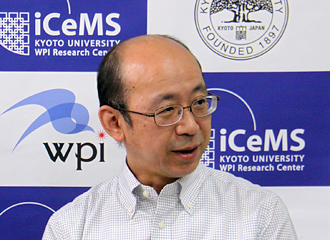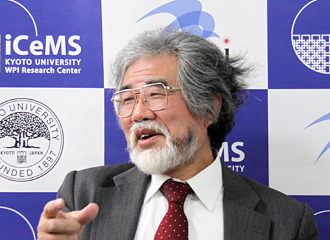[Nat Biotechnol] Genetic Changes Mapped in a Diverse Sample of ES Cells: the ISCI Takes a Major Step Toward Medical Applications

November 28, 2011
In a major announcement, the International Stem Cell Initiative (ISCI) has identified genetic changes that take place during the culture of embryonic stem (ES) cells. The effort, led by Prof. ![]() Peter Andrews of the University of Sheffield, analyzed 125 human ES cell lines and 11 human induced pluripotent stem (iPS) cell lines collected from 38 laboratories across 19 countries. These findings are expected to bring about the development of accurate and cost-effective approaches to cell line assessment and quality control, which are needed in the application of stem cell technologies to regenerative medicine.
Peter Andrews of the University of Sheffield, analyzed 125 human ES cell lines and 11 human induced pluripotent stem (iPS) cell lines collected from 38 laboratories across 19 countries. These findings are expected to bring about the development of accurate and cost-effective approaches to cell line assessment and quality control, which are needed in the application of stem cell technologies to regenerative medicine.
A Kyoto University team, headed by iCeMS Director Norio Nakatsuji and Assoc. Prof. ![]() Hirofumi Suemori of the Institute for Frontier Medical Sciences (IFMS), contributed samples of three human ES cell lines -- derived and cultured at the IFMS -- to the study. The team has been involved with the ISCI project since its inception in 2003. Shinya Yamanaka,
Hirofumi Suemori of the Institute for Frontier Medical Sciences (IFMS), contributed samples of three human ES cell lines -- derived and cultured at the IFMS -- to the study. The team has been involved with the ISCI project since its inception in 2003. Shinya Yamanaka, ![]() Director of the university's Center for iPS Cell Research and Application (CiRA) and also an iCeMS Professor, as well as CiRA Senior Lecturer
Director of the university's Center for iPS Cell Research and Application (CiRA) and also an iCeMS Professor, as well as CiRA Senior Lecturer ![]() Kazutoshi Takahahi participated in the study as well, providing nine sample human iPS cell lines.
Kazutoshi Takahahi participated in the study as well, providing nine sample human iPS cell lines.
The paper appeared in the November 27 online edition of Nature Biotechnology.
 |
 |
|
| Assoc. Prof. Suemori (left) and Prof. Nakatsuji taking questions during a press briefing |
||
Further details
- Press release jointly issued by the University of Melbourne and Stem Cells Australia:
 "Australian contribution to international study to address safety"
"Australian contribution to international study to address safety" - Press release issued by the Singapore Agency for Science, Technology and Research (A*STAR):
 "Singapore Scientists Lead Human Embryonic Stem Cell Study to Advance the Field of Regenerative Medicine Research"
"Singapore Scientists Lead Human Embryonic Stem Cell Study to Advance the Field of Regenerative Medicine Research"
Publication Information
![]() Screening ethnically diverse human embryonic stem cells identifies a chromosome 20 minimal amplicon conferring growth advantage
Screening ethnically diverse human embryonic stem cells identifies a chromosome 20 minimal amplicon conferring growth advantage
The International Stem Cell Initiative (Katherine Amps, Peter W Andrews, George Anyfantis, Lyle Armstrong, Stuart Avery, Hossein Baharvand, Julie Baker, Duncan Baker, Maria B Munoz, Stephen Beil, Nissim Benvenisty, Dalit Ben-Yosef, Juan-Carlos Biancotti, Alexis Bosman, Romulo Martin Brena, Daniel Brison, Gunilla Caisander, Maria V Camarasa, Jieming Chen, Eric Chiao, Young Min Choi, Andre B H Choo, Daniel Collins, Alan Colman, Jeremy M Crook, George Q Daley, Anne Dalton, Paul A De Sousa, Chris Denning, Janet Downie, Petr Dvorak, Karen D Montgomery, Anis Feki, Angela Ford, Victoria Fox, Ana M Fraga, Tzvia Frumkin, Lin Ge, Paul J Gokhale, Tamar Golan-Lev, Hamid Gourabi, Michal Gropp, Lu Guangxiu, Ales Hampl, Katie Harron, Lyn Healy, Wishva Herath, Frida Holm, Outi Hovatta, Johan Hyllner, Maneesha S Inamdar, Astrid Kresentia Irwanto, Tetsuya Ishii, Marisa Jaconi, Ying Jin, Susan Kimber, Sergey Kiselev, Barbara B Knowles, Oded Kopper, Valeri Kukharenko, Anver Kuliev, Maria A Lagarkova, Peter W Laird, Majlinda Lako, Andrew L Laslett, Neta Lavon, Dong Ryul Lee, Jeoung Eun Lee, Chunliang Li, Linda S Lim, Tenneille E Ludwig, Yu Ma, Edna Maltby, Ileana Mateizel, Yoav Mayshar, Maria Mileikovsky, Stephen L Minger, Takamichi Miyazaki, Shin Yong Moon, Harry Moore, Christine Mummery, Andras Nagy, Norio Nakatsuji, Kavita Narwani, Steve K W Oh, Sun Kyung Oh, Cia Olson, Timo Otonkoski, Fei Pan, In-Hyun Park, Steve Pells, Martin F Pera, Lygia V Pereira, Ouyang Qi, Grace Selva Raj, Benjamin Reubinoff, Alan Robins, Paul Robson, Janet Rossant, Ghasem H Salekdeh, Thomas C Schulz, Karen Sermon, Jameelah Sheik Mohamed, Hui Shen, Eric Sherrer, Kuldip Sidhu, Shirani Sivarajah, Heli Skottman, Claudia Spits, Glyn N Stacey, Raimund Strehl, Nick Strelchenko, Hirofumi Suemori, Bowen Sun, Riitta Suuronen, Kazutoshi Takahashi, Timo Tuuri, Parvathy Venu, Yuri Verlinsky, Dorien Ward-van Oostwaard, Daniel J Weisenberger, Yue Wu, Shinya Yamanaka, Lorraine Young & Qi Zhou)
Nature Biotechnology | DOI:10.1038/nbt.2051 | Published November 27, 2011
Media coverage
- Asahi Shimbun (December 8, 2011 page 31)
 International Business Times (November 30, 2011 web)
International Business Times (November 30, 2011 web) Yomiuri Shimbun (November 29, 2011 web)
Yomiuri Shimbun (November 29, 2011 web) ABC Science (November 28, 2011 web)
ABC Science (November 28, 2011 web) The Australian (November 28, 2011 web)
The Australian (November 28, 2011 web) The Scientist (November 28, 2011 web)
The Scientist (November 28, 2011 web)- NHK Television "News 610 Kyo Ichinichi" (November 28, 2011, 18:10-19:00)
 Asahi Shimbun (November 28, 2011 web)
Asahi Shimbun (November 28, 2011 web) Kyoto Shimbun (November 28, 2011 page 23)
Kyoto Shimbun (November 28, 2011 page 23) The Nikkei (November 28, 2011 page 11)
The Nikkei (November 28, 2011 page 11)
